In the field of positional astronomy, the term “opposition” refers to the alignment of two celestial objects on opposite sides of the celestial sphere, as viewed from a third celestial body, often Earth.
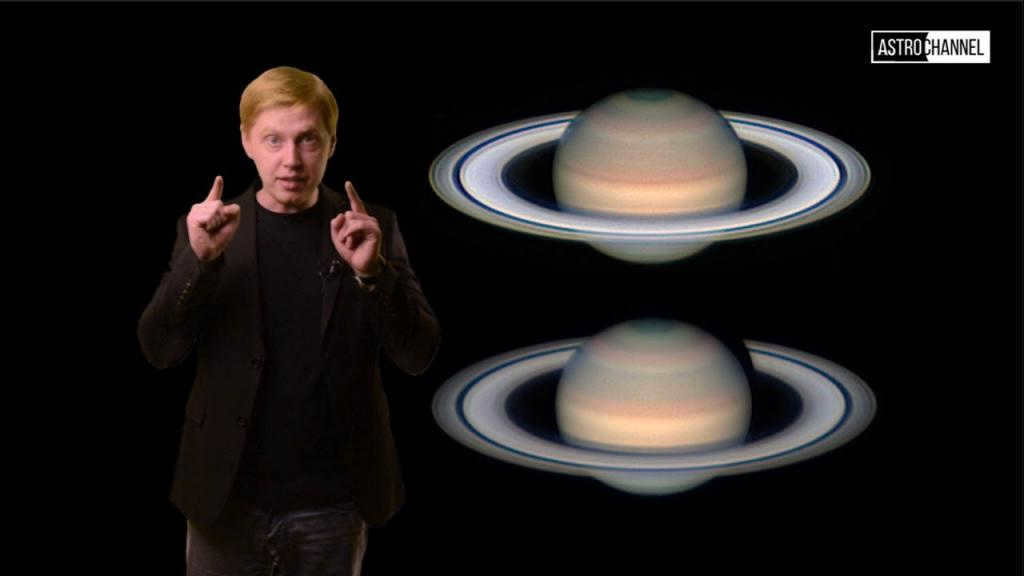
When a planet (or asteroid/comet) is positioned directly across from the Sun, it is referred to as being in opposition. This alignment occurs when the Earth, the Sun, and another celestial body are all situated on the same straight line or sisigy. It is worth noting that opposition exclusively occurs with the outer planets, as their orbits are nearly parallel to the ecliptic, which is the path the Sun appears to travel along in the sky.
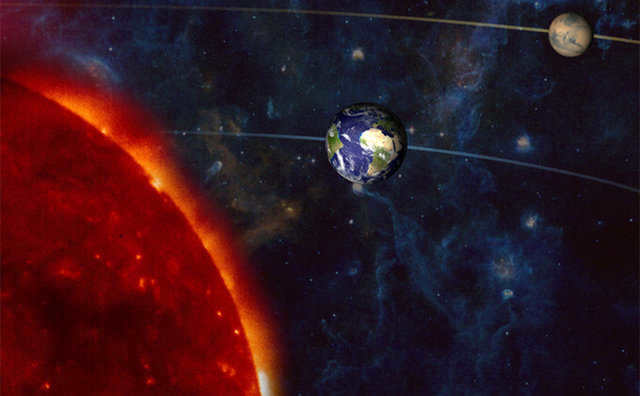
Specifics
When observed from a superior planet, the inferior planet positioned on the opposing side of the Sun is in a state of complete conjunction with it. A minimal conjunction transpires when two planets align on the identical side of the Sun. In this case, the planet located at a higher position “opposes” the celestial body when observed from its vantage point.
The significance of Mars
Similar to the other planets within our solar system, both Earth and Mars orbit around the Sun. However, Earth is positioned closer to the Sun, causing it to move at a faster pace within its orbit. In the same span of time that Mars completes one revolution, Earth completes two revolutions around the Sun.
Consequently, there are moments when these two planets are positioned on opposite sides of the Sun, resulting in a significant distance between them. Conversely, there are also occasions when Earth catches up to Mars and passes by in relatively close proximity.
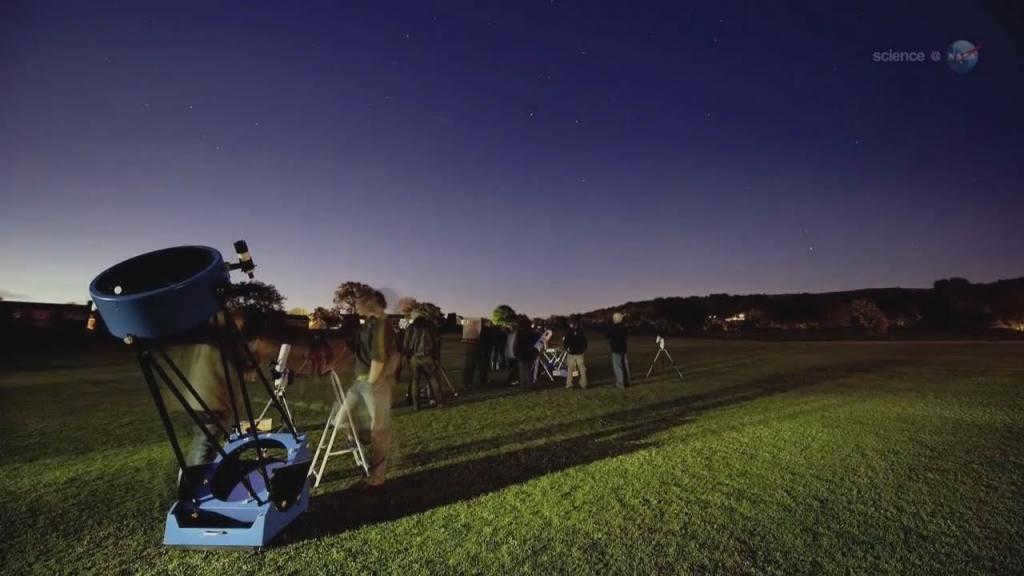
The Clash of Planets: Earth vs. Mars
During a planetary opposition, Earth and Mars find themselves directly opposite each other, with the Sun situated in between. From our vantage point on our spinning planet, we witness the red planet rising in the east just as the sun bids farewell in the west. Throughout the night, Mars remains visible in the sky until it sets in the west, coinciding with the sunrise in the east.
Due to the Sun and Mars appearing on opposite sides of the celestial dome, we describe this phenomenon as the Red Planet being in a state of “opposition.” In the event that both Earth and Mars were following perfectly circular orbits, this opposition would mark the closest proximity between the two planets.
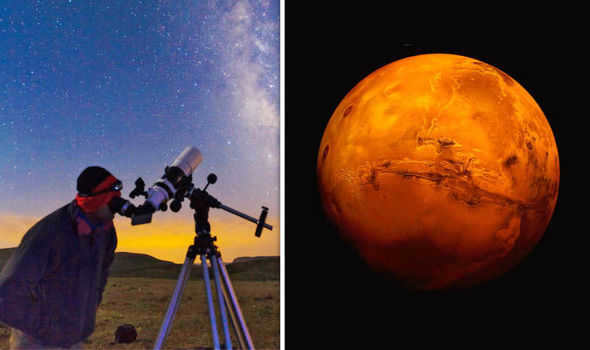
Periodicity
Oppositions of planets, such as Mars, happen approximately every 26 months. These oppositions usually occur within a few weeks of the planet’s perihelion, which is the point in its orbit when it is closest to the Sun.
Last year, the opposition of Mars occurred on July 27, 2018. This opposition can happen at any point in Mars’ orbit. When it does occur, and Mars is at its closest point to the Sun (known as a “perihelion opposition”), it is also particularly close to Earth. If both Earth and Mars had completely stable orbits, then each perihelionic opposition would bring the two planets as close together as possible. This is mostly the case.
However, once again, nature introduces a number of complexities. The shape of our orbits is constantly being altered by the gravitational force of other planets. The orbit of the red planet, in particular, is significantly influenced by the massive presence of Jupiter. Furthermore, the orbits of Earth and Mars do not align perfectly: the paths of these planets are slightly inclined in relation to one another.
Differences in the paths the planets take around the sun
The path that Mars takes around the sun is more oval-shaped compared to the path that Earth takes. This means that the distance between Mars and the sun varies more between its closest point (perihelion) and its farthest point (aphelion). Over time, Mars’ orbit has become even more elongated, bringing it even closer to the sun at perihelion and even farther away at aphelion. As a result, in the future, when Mars and Earth are at their closest points to the sun, they will be even closer to each other than before.
Unlike Earth, Mars, and the other planets in our solar system, don’t have a fixed location in the vastness of space. They are constantly moving and don’t have a permanent address. Because of this, they were given the name “wanderers.” The positioning of the planets has a significant impact on how we observe them from Earth.
Positional astronomy
Positional astronomy involves observing two celestial bodies from a particular vantage point, with the bodies positioned on opposite sides of the celestial sphere. When two planets are separated by an angle of 180° in relation to the Sun, they are considered to be in opposition, which is the maximum elongation. In other words, a planet is said to be in opposition when it is directly across from the Sun in the Earth’s sky, or when the Sun is positioned between the planet and the observer.
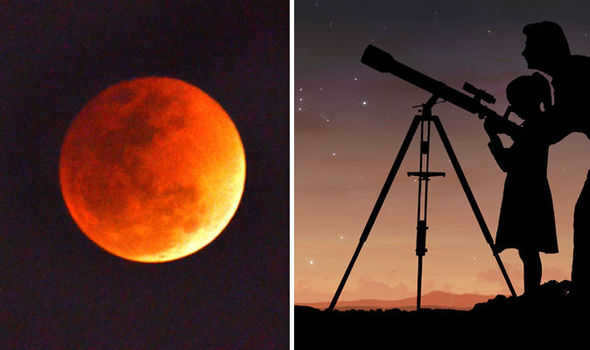
When observing the planets, it is important to keep in mind that the Sun serves as the point of reference. Planets that have orbits outside of Earth’s orbit may sometimes appear in opposition to it. One optimal time to observe a planet is during solar elongation. However, it is worth noting that the lower planets, such as Mercury and Venus, have elongation periods that differ from those of the higher planets, which are positioned farther from the Sun than from Earth.
Additional features
Opposition occurs when the Earth and the Sun align in a straight line with another celestial body, making it appear opposite to us. On the other hand, conjunction occurs when the Earth and another celestial body lie on opposite sides of the Sun. Interestingly, during the opposition of certain planets, they come closer to the Earth, providing a great opportunity for observation.
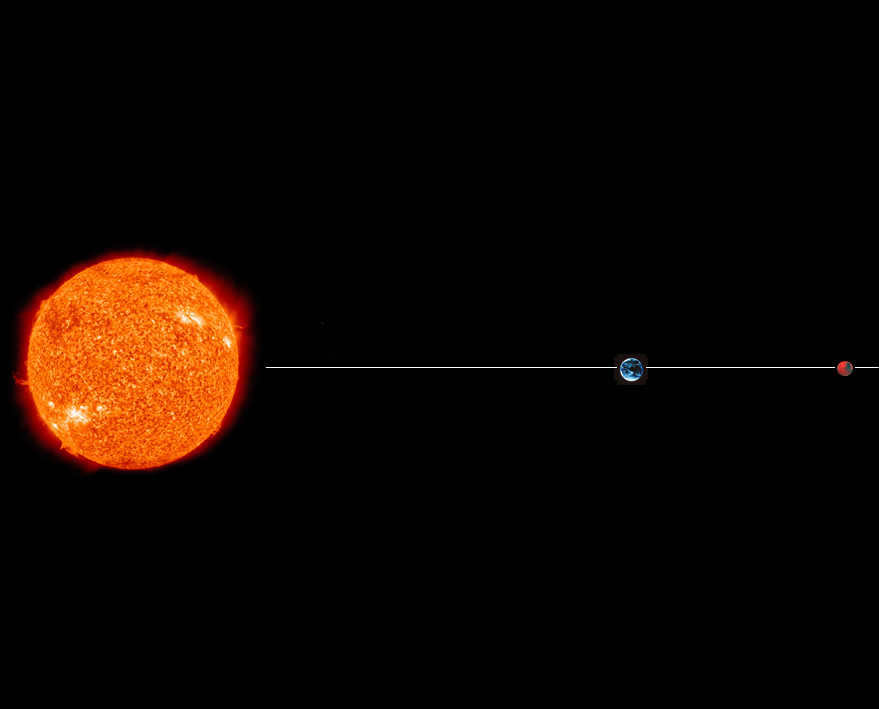
Jupiter
What other planets can be observed in opposition, apart from Mars? The largest celestial body in our solar system must be mentioned first. Jupiter is the biggest planet and the fifth one from the Sun. It is known for its vibrant striped appearance on its surface and a large red spot located near the equator.
Jupiter orbits the Sun with a period of approximately 11.86 years. In ancient China, the year was determined based on the position of Jupiter in the sky and aligned with the 12 earthly branches (a cycle of 12 animals). As a result, it is also referred to as the Star of the Ages. Jupiter’s opposition occurs roughly once every 399 days.
Jupiter is the second most luminous planet following Venus. During the period surrounding the opposition, Jupiter can exhibit a remarkable brightness, attaining a visual magnitude of approximately -2.5*. This presents an opportune moment for observing not only Jupiter itself, but also its renowned Great Red Spot and its four largest moons – Io, Europa, Ganymede, and Callisto. It is recommended to employ a telescope with a magnification of 40x or higher when undertaking observations of Jupiter.

Visual magnitude
The visual magnitude serves as a way to gauge the brightness of a celestial body. When observing a faint star, its visual magnitude will tend to be large and positive. Conversely, as a celestial object grows brighter, its visual magnitude will decrease. The most brilliant objects in the sky will possess negative magnitudes (for instance, the Sun and full Moon have visual magnitudes of -26.8 and -12.5, respectively). On a clear evening, the least luminous stars will typically have magnitudes around +6.
Opposition in the past
What can we say regarding the timing of planetary oppositions? It has been noted that Mars achieved opposition on July 27, 2018. However, what does this signify? It indicates that Mars is highly luminous and can be easily observed in the night sky. This event is referred to as opposition because it occurs when Mars is positioned 180 degrees opposite to the Sun, in close proximity to it. As the Sun sets, Mars starts to rise and travels across the sky during the night, vanishing at daybreak.
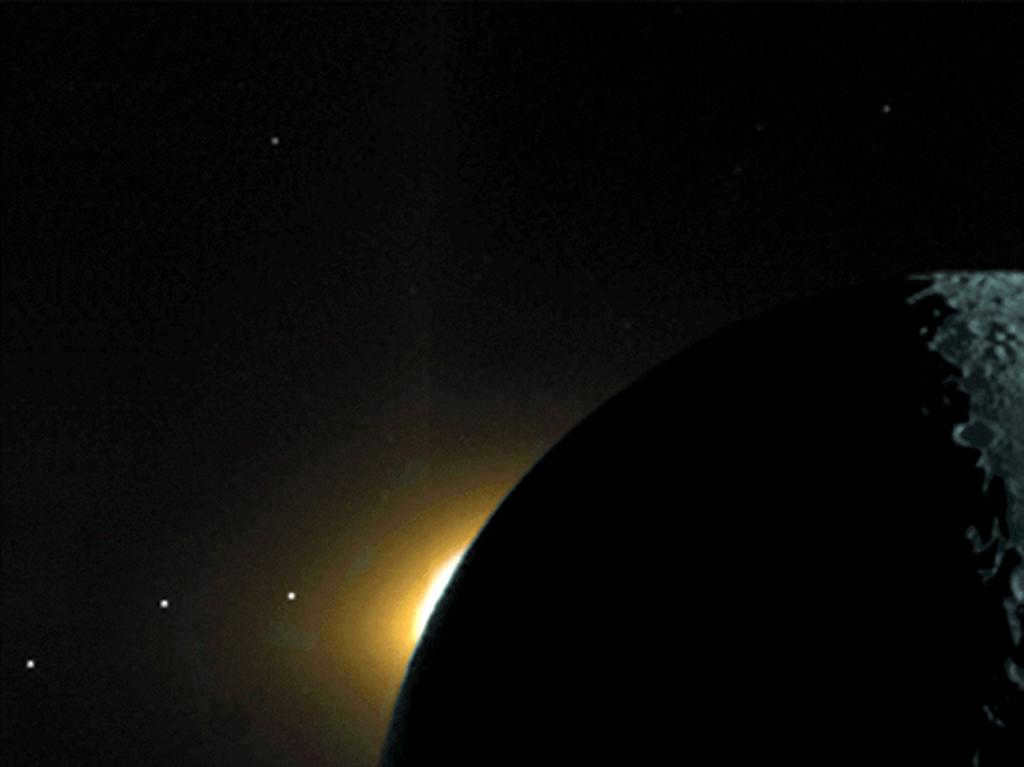
The phenomenon of opposition also takes place when the planet’s distance from Earth reaches a relative minimum. As a result, the planet appears larger and brighter in our sky due to its closer proximity. Jupiter’s opposition occurred on May 9th, followed by Saturn’s on June 27th, making it a fruitful summer for enthusiasts of planetary observation. (Uranus, Neptune, and Pluto also reached opposition this year, but they are relatively obscure, making them difficult to spot for casual stargazers.)
Which planets can be observed at opposition? This question has been addressed before, but it largely depends on the planet’s orbit. The orbit determines when the opposition occurs, and Mars’ oppositions are slightly more complex compared to other planets due to its highly elliptical orbit, unlike the more circular orbits of Jupiter and Saturn.
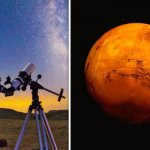
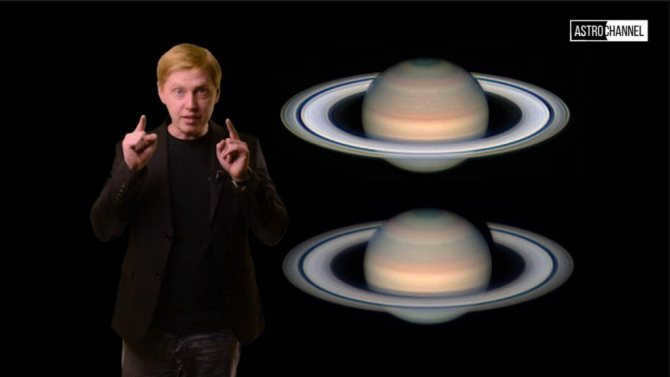
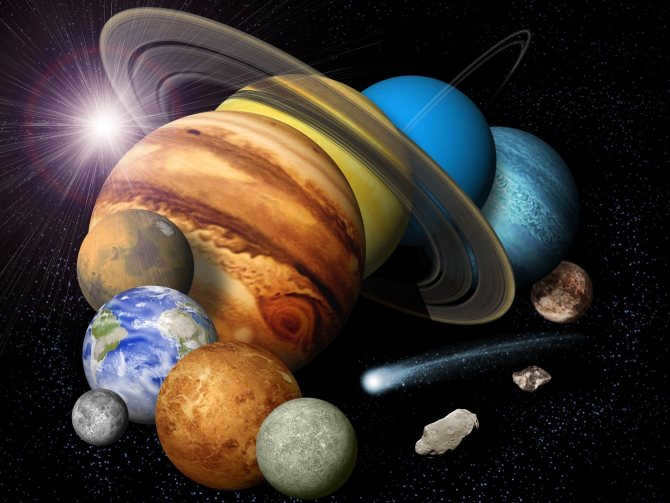
All planets in relation to Earth can be classified as either inner planets (with orbits inside Earth’s orbit) or outer planets. The inner planets consist of Venus and Mercury, while the outer planets include all others. The inner planets exhibit a conjunction configuration.
A conjunction occurs when an inner planet is either between Earth and the Sun or positioned behind the Sun. In both cases, the inner planet becomes invisible. When the planet is positioned between Earth and the Sun, it is referred to as the lower conjunction, where it is closest to Earth. On the other hand, when the planet is positioned behind the Sun, it is known as the upper conjunction, where it is farthest away from Earth.
The inner planets do not move away from the Sun at large angles (Mercury’s maximum angle is 28°, Venus’s maximum angle is 48°). The greatest deviation of the planets from the Sun to the west is known as the greatest western elongation, and to the east, it is known as the greatest eastern elongation.
Arrangements of planets
For the outer planets, there is also the possibility of a conjunction arrangement (position “behind the Sun”). During this time, they cannot be seen by an observer from Earth because they are obscured by the Sun’s rays. The position of the outer planets along the Earth-Sun line is referred to as opposition. This configuration is the most favorable for observing the planets.
Planetary Orbital Periods
The synodic period of a planet refers to the time it takes for the planet to repeat its configurations.
The speed of a planet’s motion is greater when it is closer to the Sun. As a result, after opposition, the Earth will surpass planets that are farther from the Sun. Eventually, there will be a confrontation again as the Earth completes a full revolution and overtakes the planets.
We can define the synodic period of an outer planet as the time it takes for the Earth to overtake the planets by 360° in their motion around the Sun.
The sideric period is the time it takes for a planet, as observed from the Sun, to return to the same star.
There is a relationship between the synodic period (S, in days) and sideric period (T, in days) for planets that are located between the Sun and the Earth:
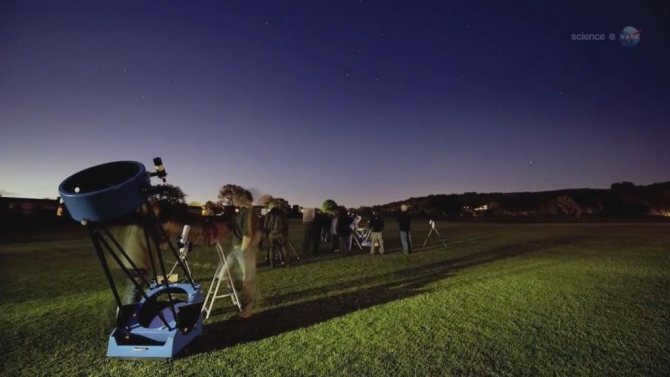
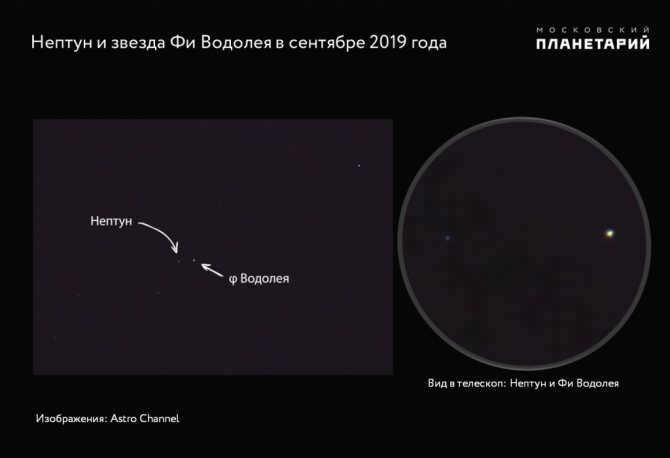
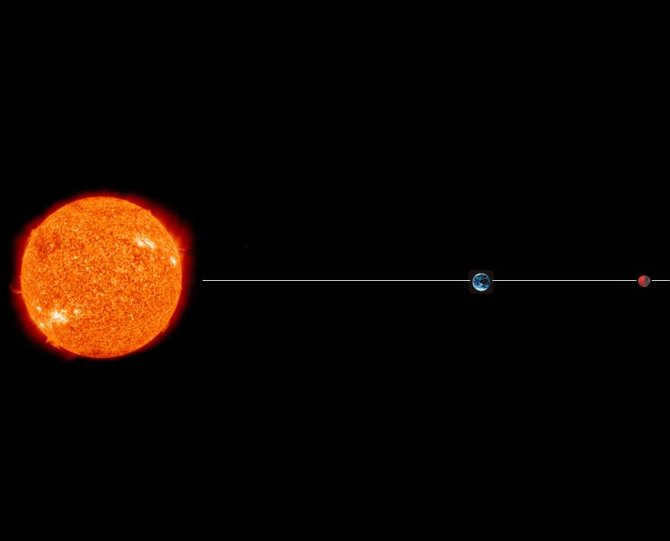
Opposition of Planets: Earth and Mars
During the planetary opposition phenomenon, Mars and the Sun are positioned directly across from each other in relation to the Earth. From our perspective on our spinning planet, the Red Planet emerges on the eastern horizon just as the sun sets in the western sky. It then remains visible throughout the entire night before setting in the west as the sun rises in the east.
Due to the fact that Mars and the Sun are located on opposite sides of the celestial sphere, we refer to this configuration as the Red Planet being in “opposition.” If Earth and Mars were following perfectly circular orbits, the opposition would represent the closest proximity between the two planets.
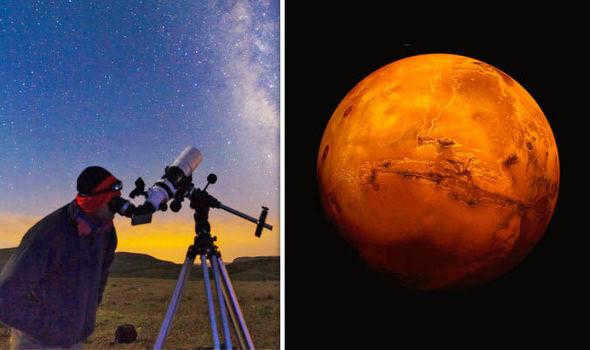
Kepler’s Laws
Johannes Kepler (1571-1630) derived his laws by examining the periodic revolution of Mars around the Sun.
Kepler’s First Law states that each planet revolves around the Sun in an elliptical orbit, with the Sun positioned at one of the focal points. The point of the orbit that is nearest to the Sun is known as the perihelion, while the point that is farthest from the Sun is called the aphelion. The extent of the elongation of the ellipse is determined by its eccentricity.
According to Kepler’s second law, the planet’s radius vector covers equal areas in equal time intervals. While the areas may be the same, the arcs described by the planet in different parts of its orbit vary. Consequently, the linear velocity of the planet is not constant throughout its orbit. The planet moves faster when it is closer to the Sun, with the greatest speed achieved at perihelion.
In summary, Kepler’s second law provides a way to quantify the variation in the planet’s velocity along the ellipse.
Kepler’s second law
Kepler’s third law states that the squares of the periods of planetary orbits are proportional to the cubes of their semi-major axes. If we denote the semi-major axis and period of revolution of one planet as a1 and T1, and another planet as a2 and T2, then the formula for the third law can be expressed as:
Kepler’s third law establishes a relationship between the lengths of the semi-major axes of planetary orbits and the semi-major axis of Earth’s orbit. In the field of astronomy, this distance is considered as the fundamental unit of measurement known as the astronomical unit (a.e.).
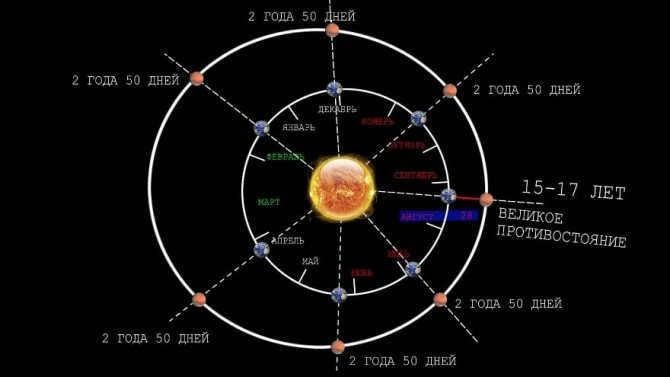
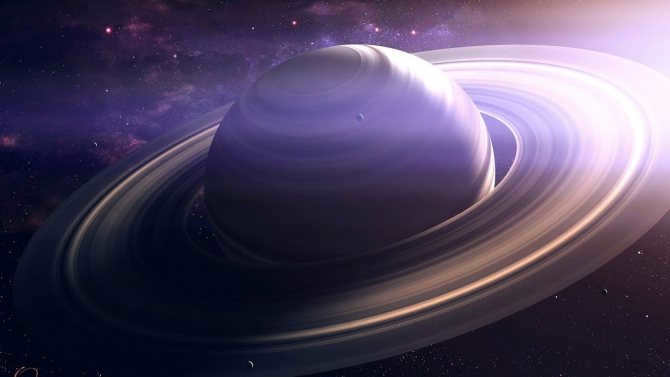
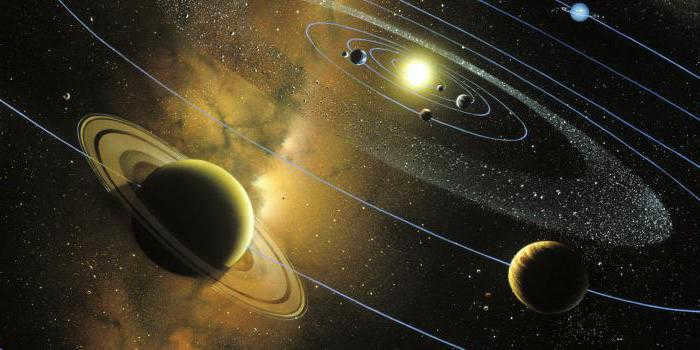
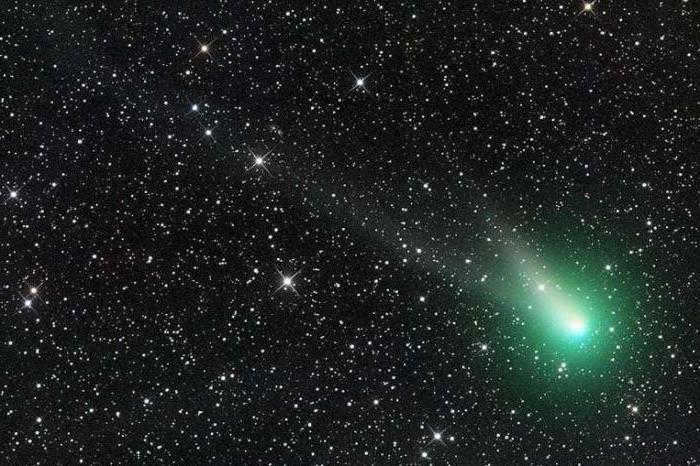
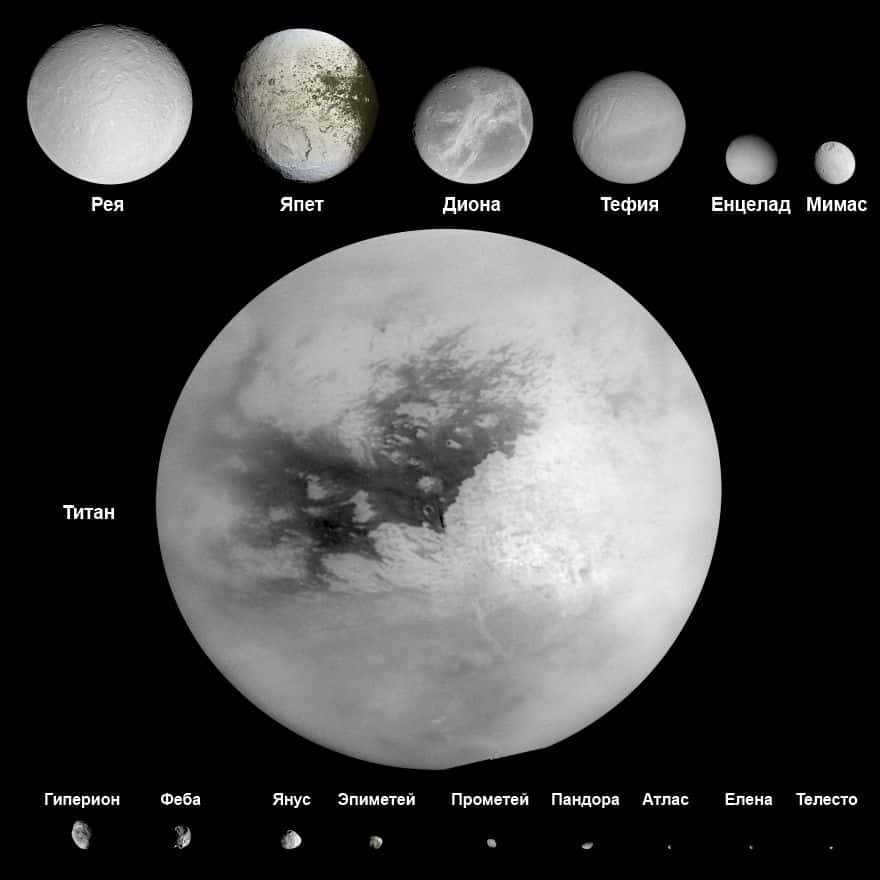
Differences in the paths of celestial bodies
The orbit of Mars differs from that of Earth in that it has a more elliptical shape. This means that the distance between the closest point to the Sun (perihelion) and the farthest point (aphelion) is greater for Mars compared to Earth. Over time, the orbit of Mars has become increasingly elongated, bringing it even closer to the Sun at perihelion and further away at aphelion. As a result, future perihelionic planetary oppositions will bring Earth and Mars into even closer proximity.
Unlike Earth, which has a fixed position in space, planets in the solar system, including Earth, have no permanent location and are often referred to as wanderers. This lack of a fixed address has significant implications for planetary observations.
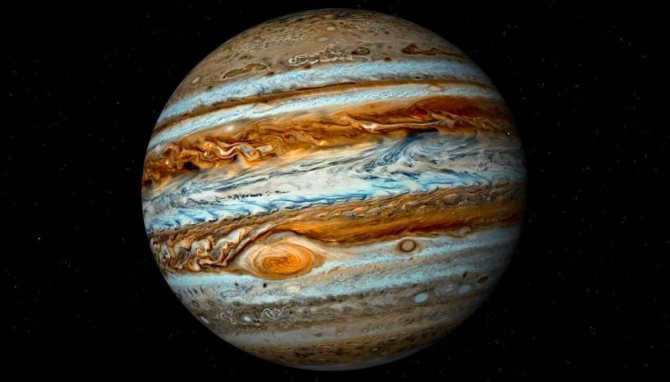
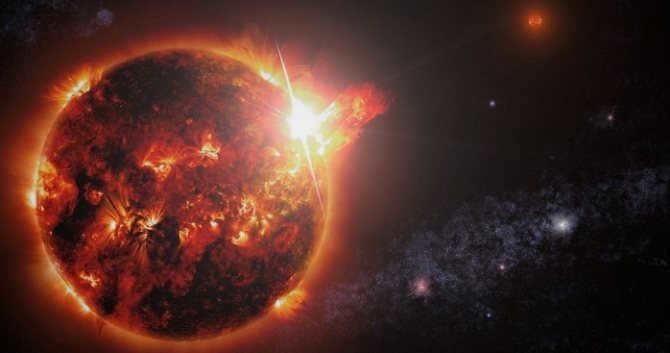
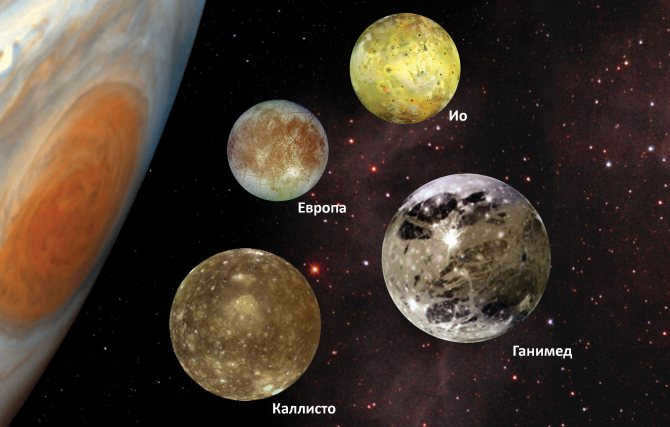
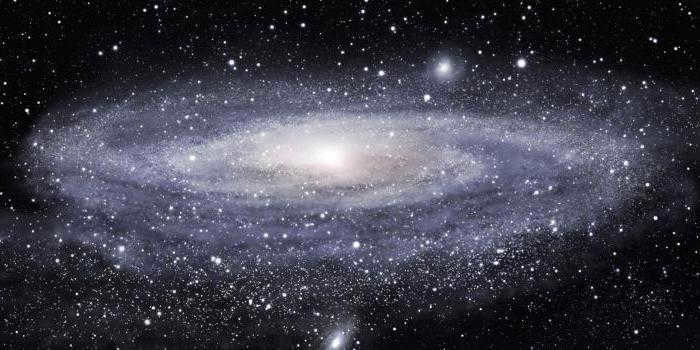
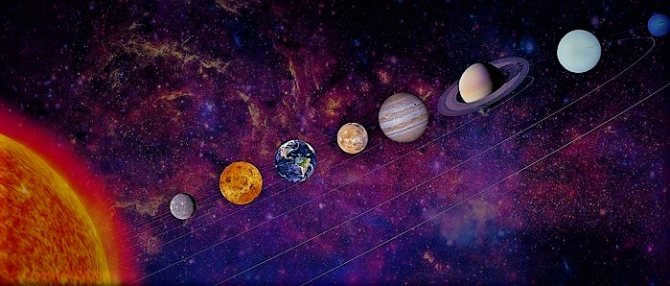
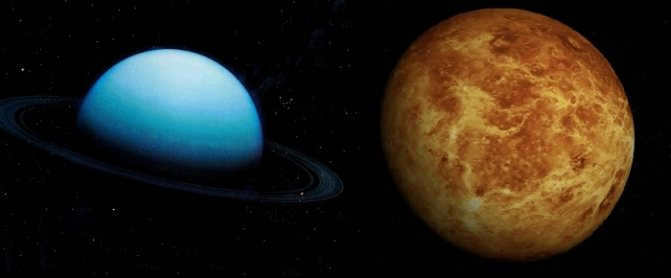
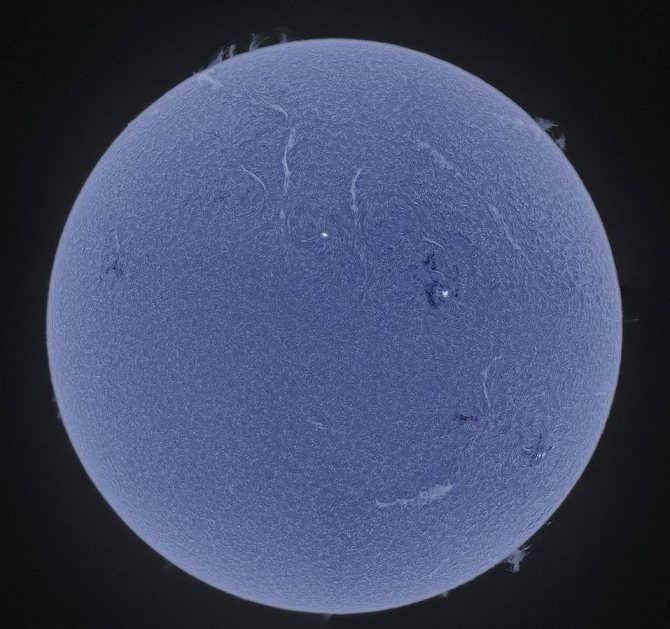
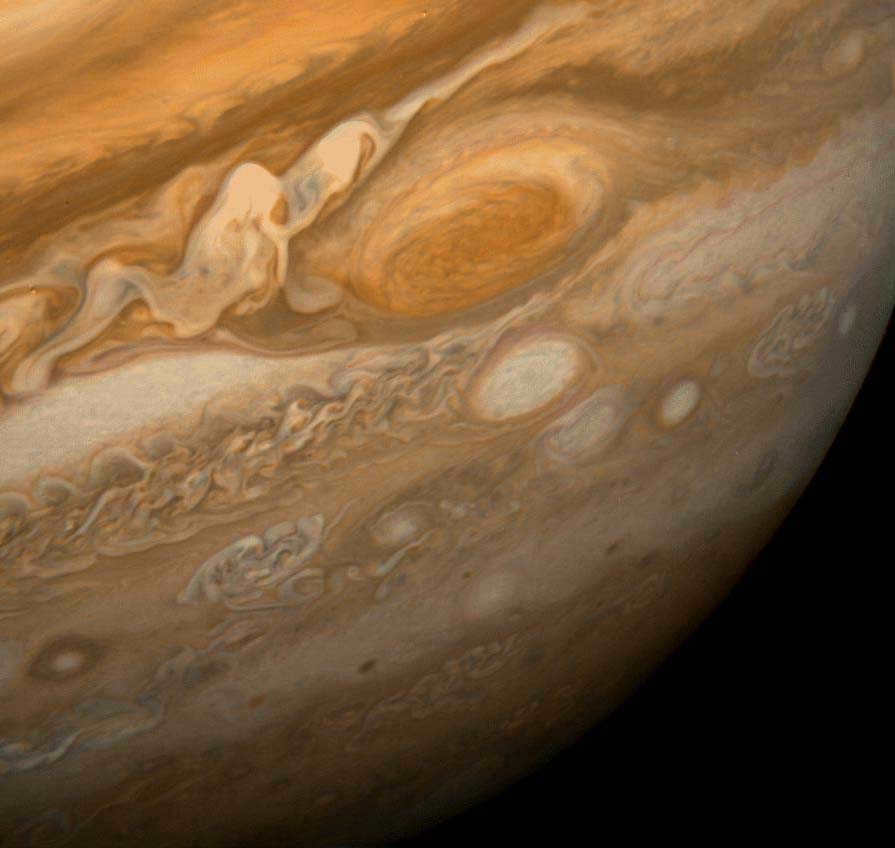
What is there to say about planetary opposition dates? You may have been informed that Mars achieved opposition on July 27, 2020. However, what does that signify? It signifies that Mars is luminous and readily observable in the nocturnal heavens. It is referred to as opposition because it is positioned 180 degrees from the Sun, which is in close proximity. When the celestial body descends, Mars ascends and traverses the firmament throughout the nocturnal period, vanishing at daybreak.
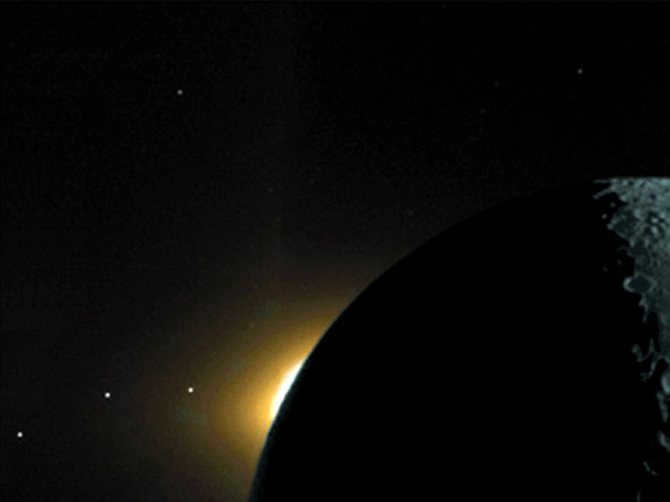
The phenomenon of opposition also occurs when a planet’s distance from Earth reaches its relative minimum, resulting in a larger and brighter appearance in our sky. As we have already witnessed this summer, Jupiter reached opposition on May 9th, followed by Saturn on June 27th. It has been a rewarding season for those interested in observing planets. (Although Uranus, Neptune, and Pluto also reached opposition this year, they are relatively obscure and may go unnoticed by most casual stargazers.)
So, which planets can we expect to see at opposition? As previously mentioned, this largely depends on their orbit. In the case of Mars, its oppositions are a bit more complex compared to planets like Jupiter and Saturn due to its significantly more elliptical orbit.
In the early 1600s, astronomer Johannes Kepler provided an explanation that the planets do not orbit the Sun in perfect circles but instead in elongated circles called ellipses. This discovery helps us understand how and which planets interact with each other when they are in opposition.
The Planet Saturn
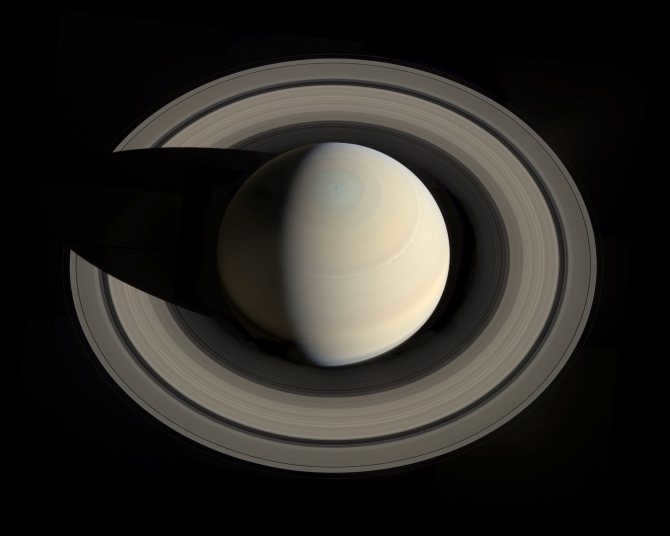
Saturn, a compilation of 8 photographs taken by the Cassini spacecraft
It ranks second in terms of size and number of moons among all planets, and its position in relation to the Sun is among the giant planets. Jupiter holds the top spot in these categories. Other giant planets include Uranus and Neptune. One unique feature of Saturn is its ring system, which is easily visible through a regular telescope.
The initial observations of the celestial bodies
For thousands of years, humans have been studying the visible movements of the stars and other cosmic phenomena. The first written records about celestial bodies can be found in ancient Egyptian and Sumerian chronicles. The Egyptians were able to identify three types of objects in the sky: stars, planets, and “stars with tails”. Over time, they discovered additional celestial bodies such as Saturn, Jupiter, Mars, Venus, Mercury, the Sun, and the Moon. The visible movements of these celestial bodies refer to their observed motion from Earth’s perspective, independent of its daily rotation. The actual motion of these space bodies, on the other hand, is determined by the external forces acting upon them.
Also, check out: The first-ever photograph of Mars was hand-colored. Find out why.
Jupiter
What other planets can be seen in opposition, aside from Mars? It is important to note the largest celestial body in our solar system. Jupiter is the biggest planet and the fifth one from the Sun. It is characterized by vibrant stripes on its surface and a large red spot near its equator.
Jupiter orbits the Sun with a period of approximately 11.86 years. In ancient China, the year was measured based on Jupiter’s position in the sky and corresponded to the 12 Earthly branches (the cycle of 12 animals). Therefore, it is also known as the Star of the Ages. The opposition of Jupiter occurs approximately once every 399 days.
Jupiter is the second most luminous planet following Venus. During the period surrounding the opposition, Jupiter shines with great intensity, achieving a visual magnitude of approximately -2.5*. This presents an excellent opportunity to witness its awe-inspiring features, including the Great Red Spot and its four largest moons: Io, Europa, Ganymede, and Callisto. For optimal observation of Jupiter, it is recommended to utilize a telescope with a magnification of 40x or greater.

From Brahe to Kepler: a Journey through Time

Following the death of Copernicus, Tycho Brahe, a Danish astronomer, took up his work. Brahe, who was incredibly wealthy, transformed one of his private islands into a research facility. On this island, he installed impressive bronze instruments to record his observations of celestial bodies. These observations proved to be invaluable to Johannes Kepler, a mathematician, in his own studies. Kepler, a German, was able to organize the movements of the planets in the solar system and establish his famous set of three laws based on Brahe’s data.
Neptune
Neptune, also known as the eighth planet from the Sun, is one of the most interesting celestial bodies in our solar system. It was named after the Roman god of the sea due to its beautiful blue color. Being the furthest planet from the Sun, Neptune is known for its extremely cold temperatures and strong winds. Its atmosphere is composed mainly of hydrogen and helium, with traces of methane that give it its distinctive blue hue. Neptune has a unique feature called the Great Dark Spot, which is a massive storm system similar to Jupiter’s Great Red Spot. This planet is also home to several moons, the largest of which is Triton. Scientists believe that Neptune may have a rocky core surrounded by a layer of icy materials.
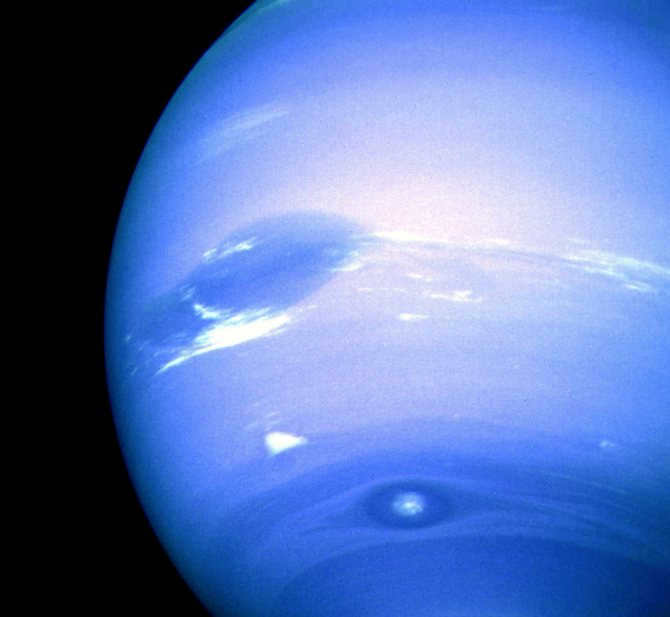
Photo of Voyager 2 capturing Neptune
Neptune shares a similar composition with Uranus, and the abundance of ice in these planets classifies them as “ice giants”. Its atmosphere, like all giant planets, mainly consists of hydrogen and helium, while the presence of methane gives Neptune its distinctive blue hue. Known for its incredibly strong winds, Neptune’s gusts can reach speeds of up to 700 km/h. Additionally, Neptune boasts a total of 13 satellites.
Comparing the sizes of planets and stars
The planet’s equatorial rotation speed is 10.89 km/h. The velocity of its orbit depends on its position within the orbit.
The minimum velocity required for an object to orbit Mercury is called the first space velocity. This velocity is calculated using a formula and is approximately 3.1 km/sec.
Until the 1960s, it was believed that Mercury rotated synchronously with the Sun and did not rotate on its own axis. This belief was based on the fact that scientists only observed Mercury from one position, resulting in consistent and identical results. Additionally, a portion of the planet was always hidden from view. It wasn’t until 1965 that American scientists were able to prove Mercury’s rotation around its axis.
Mars Moons
In the vicinity of Mars, there are two celestial bodies orbiting around it known as Phobos and Deimos. These two moons were initially discovered in 1877 by Asaph Hall, who decided to name them after figures from Greek mythology. Specifically, they were named after the sons of Ares, the god of war: Phobos, which translates to fear, and Deimos, which means terror. The photo showcases the Martian satellites in all their glory.
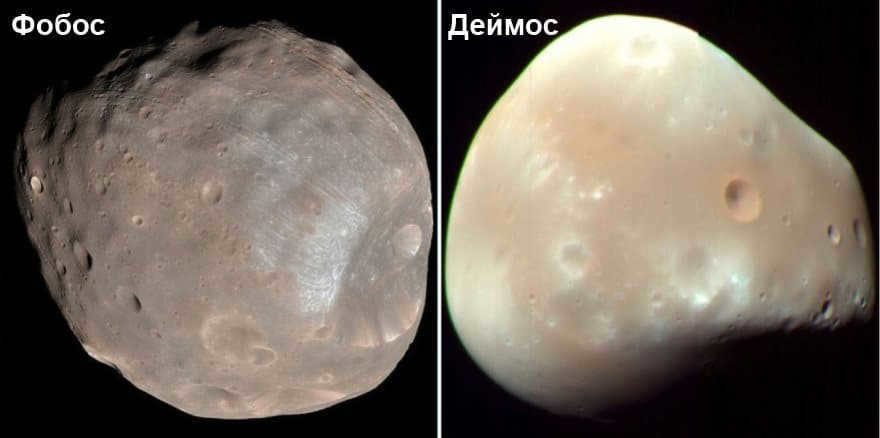

MRO captured Phobos and Deimos. These are small irregular satellites that may have been drawn towards the planet from the asteroid belt.
Phobos has a diameter of 22 kilometers and orbits at a distance of 9234.42 to 9517.58 kilometers. It takes 7 hours to complete one orbit and this time is gradually decreasing. Scientists predict that in 10-50 million years, the satellite will collide with Mars or be disrupted by the planet’s gravity, forming a ring structure.
Deimos has a diameter of 12 km and orbits at a distance ranging from 23455.5 to 23470.9 km. The duration of its orbital path is 1.26 days. Mars might also possess additional moons measuring 50-100 meters in width, and a dust ring could potentially form between these larger moons.
It is theorized that the moons of Mars were originally asteroids that were captured by the planet’s gravitational pull. However, these moons exhibit circular orbits, which is unusual for captured bodies. Another possibility is that they formed from material ejected from the planet during its early formation, but in that case, their composition would have to resemble that of a planet. Alternatively, a violent impact event, similar to the scenario involving our Moon, could have also occurred.
Venus
Venus is the second planet from the Sun in our solar system. It is also the hottest planet, with temperatures reaching up to 900 degrees Fahrenheit. Venus is often called Earth’s sister planet because they are similar in size and composition. However, Venus has a very different atmosphere, consisting mainly of carbon dioxide. The thick atmosphere creates a greenhouse effect, trapping heat and making Venus the hottest planet in our solar system. Despite its extreme temperatures and harsh conditions, scientists have discovered that Venus may have once had oceans and even harbored life.
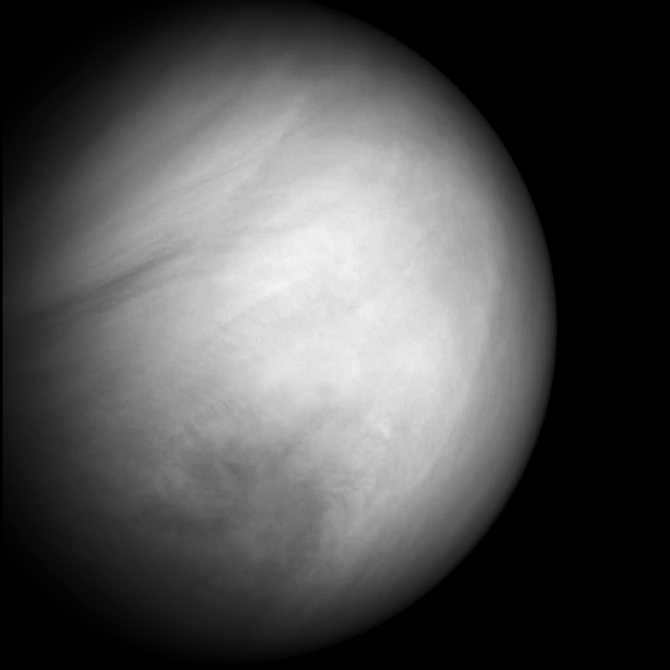
The MESSENGER spacecraft captured an image of Venus.
Renowned for its extremely high surface temperature – reaching around 480 °C – Venus holds the distinction of being the hottest planet. Its atmosphere is composed mainly of carbon dioxide and has been observed to experience thunderstorms of greater intensity than those found on Earth. Unlike many other planets, Venus does not have any natural satellites orbiting around it.
The positions of the planets determine their visibility in the sky relative to the Earth and the Sun. Since all planets reflect sunlight, the one that is closest to the Earth and illuminated by the Sun’s rays on its daytime hemisphere will appear the brightest and most visible.
The paths of two planets, Mercury and Venus, are closer to the Sun than the Earth, so they do not align directly opposite to us. When Venus or Mercury are at their closest point to the Earth, they are not visible because the side of the planet facing away from the Sun is facing us (Fig. 4.1). This arrangement is referred to as a lower conjunction with the Sun. In an upper conjunction, the planet is also not visible because the bright Sun is positioned between it and the Earth.
Figure 4.1. Different positions of Venus and Mars. Mars opposition – the planet is closest to the Earth, making it visible throughout the night in the opposite direction from the Sun. Venus is most easily seen in the evening during its eastern elongation to the left of the Sun B 1 and in the morning during its western elongation to the right of the Sun B 2
The most ideal circumstances for observing Venus and Mercury take place during elongations, which are specific configurations. During an eastern elongation (EE), the planet is visible in the evening and positioned 1 to the left of the Sun. On the other hand, during a western elongation (WE), Venus can be seen in the morning to the right of the Sun in the eastern part of the sky.
Astronomical arrangements involving prominent planets

The following symbols indicate the visibility of planets in different positions:
– PS: when a planet is in opposition to the Sun, it can be seen throughout the night;
– SP: when a planet is in conjunction with the Sun, it is not visible;
– (EE): when a planet is in eastern elongation, it can be seen in the evening in the western part of the horizon;
– WE: when a planet is in western elongation, it can be seen in the morning in the eastern part of the sky.
Sideric and synodic periods of planetary orbits
Sidereal orbital period refers to the duration of time it takes for a planet to complete a full revolution around the Sun, as observed from a fixed point in space (Fig. 4.2).
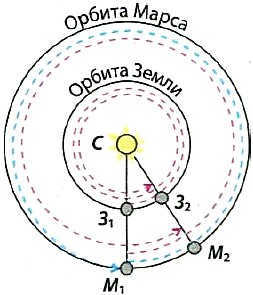
Fig. 4.2. The blue dotted line represents the orbit of Mars around the Sun during its sideric period, while the red dotted line represents its synodic period.
The synodic period of revolution is responsible for the movement of celestial bodies in relation to the Earth and the Sun. It is the time interval during which we observe the same successive configurations of the planets, such as opposition, conjunction, and elongation. In Fig. 4.2, the positions of S-Z 1 -M 1 and S-3 2 -M 2 represent two consecutive oppositions of Mars. The synodic S and sideric T periods of the planet’s revolution are related by the following equation:
Kepler’s Laws
Johannes Kepler (Fig. 4.3) discovered that the orbit of Mars is in the shape of an ellipse. This groundbreaking finding led to the realization that all other planets also follow elliptical paths around the Sun.

Figure 4.3. I. Kepler (1571-1630)
The initial principle of Kepler . Every single planet revolves around the Sun in a path that takes the shape of an ellipse, with the Sun being positioned at one of the two foci of the ellipse (Fig. 4.4, 4.5).
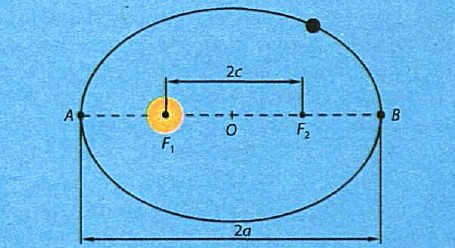
Figure 4.4. The Sun is orbited by planets in elliptical paths. The distance between the Sun and a planet is not constant and can vary within the range: r max ≤ r ≥ r min
Kepler’s first law states that a planet’s distance from the Sun changes throughout its orbit. The point A of the orbit, where the planet is closest to the Sun, is called the perihelion (derived from the Greek words peri – near and helios – the Sun). Conversely, the farthest point B of the planet’s orbit from the Sun’s center is called the aphelion (derived from the Greek words aro – far away). The sum of the distances in the perihelion and aphelion is equal to the major axis AB of the ellipse: r max + r min = 2a. The major semi-axis of the Earth’s orbit (OA or OB) is referred to as the astronomical unit. 1 astronomical unit (a. u.) is equivalent to 149.6×10 6 km.
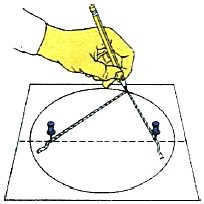
Figure 4.5. Correct method for drawing an ellipse
The degree of elongation of an ellipse can be defined by its eccentricity (e) – the ratio of the distance between the foci (2c) to the length of the major axis (2a), i.e., e=c/a, 0 Encyclopedic Dictionary
The positions of the planets where they can be observed from Earth in directions opposite to the Sun. This phenomenon is only possible for the outer planets. During planetary opposition, their retrograde motion can be observed… Astronomical Dictionary
Same as planetary oppositions. * * * * * Planet Opposition Planet Opposition, same as planetary oppositions (see PLANET Oppositions) … Encyclopedic Dictionary
Same as planetary oppositions… Large Encyclopedic Dictionary
Observable from Earth, the planets exhibit a motion relative to the stars in the east-west direction, which is contrary to the direction of their revolution around the Sun. The retrograde motion of the planets is a result of their and the Earth’s movement along their respective orbits. This phenomenon is observed in the case of the outer planets when they are in opposition… … as stated in the Encyclopedic Dictionary
The visible movement of planets occurs from east to west, in the opposite direction of their orbit around the Sun. The retrograde motion of the planets is caused by the motion of the planet itself and the Earth along their respective orbits. It can be observed when the planet is close to opposition… … according to the Large Encyclopedic Dictionary
Observable from our planet, the planets appear to move in the opposite direction to their actual orbit around the Sun. This phenomenon, known as retrograde motion, occurs because of the relative motion of Earth and the planets in their respective orbits. Retrograde motion is most noticeable when planets are near opposition, and it has been documented in various sources, including Natural History and Encyclopedic Dictionary.
In astronomy, the positions of the planets, the Moon, and other objects in the solar system in relation to the Earth and the Sun are known as celestial motion. When it comes to the lower planets such as Mercury and Venus, there are distinctions between upper and lower conjunctions, as well as eastern and western elongations. This information can be found in the Encyclopedic Dictionary.
Teacher: Galina Vladimirovna Elakova.
Place of work: MBOU “SOSH No. 7” in Kanash, Chuvash Republic.
Test on the topic: “Visible motion of the planets”.
A thematic control test can be administered orally or in written form, either individually or in groups with varying levels of preparation. This type of test is efficient in terms of time and allows for an individualized approach.
This examination provides a quick and objective way to evaluate the students’ level of preparation, identify common mistakes and knowledge gaps. The examination consists of 10 questions, each with multiple answer choices from which the students must select the correct one. Considering the diverse nature of the class and the individual abilities of the students, the teacher may choose to assign certain tasks selectively. Throughout the school year, students can progress from one difficulty level to a higher one. The examination is designed to be completed within 10-15 minutes. While performing the tasks, students should utilize the applications provided in the textbook and refer to the tables for necessary values when solving problems. The tasks and assignments included in the examination aim to develop the skills required by the curriculum and assess the extent of their development and the students’ knowledge on the key topics of the astronomy course. The assessment of students’ knowledge based on the examination results can be done on a scale:
Grade “4” is awarded if the number of correct responses falls within the range of 6 to 7 tasks;
Tasks 9-10 are specifically designed for advanced students and as preparation for astronomy Olympiads.
Variant I:
1. Which planets can be observed in opposition? Which cannot?
A) The outer planets can be observed in opposition. The inner ones (Venus and Mercury) cannot.
B) The outer planets cannot be observed in opposition. The inner planets (Venus and Mercury) can.
C) Both inner and outer planets can be observed in opposition.
2. In what configuration and why is it most convenient to observe Mars?
A) Mars is best observed near elongations.
B) At opposition, because at this time it is closest to the Earth, turned to it with the whole illuminated hemisphere, visible all night.
C) Mars can be seen in the western sky shortly after sunset during eastern elongations, and in the eastern sky shortly before sunrise during western elongations.
3. Which configuration can include both inner and outer planets?
B) All planets can be in a lower conjunction.
C) All planets can be in an upper conjunction.
4. What causes the Sun’s direct ascension and declination to change throughout the year?
A) The change in direct ascension is due to the Earth’s annual rotation, while declination is caused by the tilt of its axis of rotation.
B) The change in direct ascension is due to the Earth’s daily rotation, while declination is caused by the tilt of its axis of rotation.
5. Is it possible to observe a planet located in the constellation Capricorn from the North Pole of the Earth?
A) Yes, because the constellation Capricorn is entirely in the northern hemisphere of the starry sky.
B) No, because the constellation Capricorn is entirely in the southern hemisphere of the starry sky.
C) No, because the constellation Capricorn is visible from all latitudes.
6. If you were at the North Pole of the Sun, which direction would the planet revolve around it – clockwise or counterclockwise?
A) Counterclockwise.
B) In the direction of clockwise motion.
7. In 1959, Mars passed through the constellations Scorpio, Virgo, Leo, Cancer, Gemini, Taurus, and Aries in direct motion. In which direction did it move – from Scorpio to Aries or from Aries to Scorpio?
A) Moving from Scorpio to Aries.
B) Moving from Aries to Scorpio.
8. How often do the oppositions of Mars occur, given that its sideric period is
9. What is the orbital period of Jupiter around the stars if its synodic period is 400 days?
A) 11.4 years
B) 2.1 years
C) 3 years.
10. Determine whether the center of mass of the solar system is inside or outside the Sun, neglecting the masses of all planets except Jupiter. The mass of the Sun is 1050 times the mass of Jupiter. It is known that the diameter of the Sun is 108 times smaller than the distance from the Sun to the Earth, and the distance from the Sun to Jupiter is 5.2 times the distance from the Sun to the Earth (5.2 a.u.). The distance from the Sun to the Earth is 147,100,000 km.
Variant II :
1. Which planets are not capable of being in a lower conjunction?
A) The inner planets (excluding Venus and Mercury) are not capable of being in a lower conjunction.
B) The outer planets (excluding Venus and Mercury) are not capable of being in a lower conjunction.
C) All planets are not capable of being in a lower conjunction.
2. Which planets are capable of being in an upper conjunction?
A) Only the outer planets (excluding Venus and Mercury) are not capable of being in an upper conjunction.
B) Only the outer planets (excluding Venus and Mercury) are capable of being in an upper conjunction.
C) Only the outer planets (excluding Venus and Mercury) are not capable of being in an upper conjunction.
3. Which planets can be observed alongside the Moon during a full moon?
A) Only the outer planets can be seen in opposition near the full Moon.
B) Only the inner planets can be observed in opposition when the full Moon is near.
4. Where on the globe is there an equal amount of day and night throughout the year? Why?
A) At the Earth’s equator, because the Sun’s daily path is always divided exactly in half by the horizon.
B) At the North Pole, because the Sun is always at its highest point there.
B) Beyond the polar circles, where all the stars rise and set simultaneously.
5. During what time interval do moments of maximum distance of Venus from the Earth repeat, if its orbital period is 225 days?
A) 500 days.
B) 587 days.
C) 225 days.
6. Do the outer planets have phases like the inner planets, Mercury and Venus?
A) No phases are observed in the outer planets.
B) Only Mars among the outer planets has phases.
C) Phases can be observed on all the outer planets.
7. What is the orbital period of Venus around the Sun if its upper conjunctions with the Sun occur every 1.6 years?
A) 2 years
B) 1.5 years
C) 0.61 years (or 223 days).
8. A year on Mercury lasts 88 Earth days, and the rotation period around its axis is 58.7 Earth days (in the same direction). Calculate the length of a solar day on Mercury .
F) 75 days.
B) 176 days.
C) 200 days
9. There are two excerpts provided that describe Mars: "Vovka gazed at the sky with his eyes. Suddenly, within his field of vision appeared the delicate green beauty Venus. And there it was, an old friend – Mars. It appears to be particularly red today. And as always in its rightful place…" "Hovering above the peacefully slumbering towns and villages…as always in its rightful place, hung the fiery Mars, the symbol of war." What is true and what is false in these descriptions?
A) Mars does not have a permanent position in the sky and it is not a star. Venus sometimes has a greenish hue.
B) Mars does not have a permanent position in the sky and it is not a star.
C) Mars does not have a permanent position in the sky and it is not a star. Venus never appears greenish in color.
10. Why is it impossible to observe the inner planets at midnight?
Option I: 1 – A; 2 – B; 3 – C; 4 – A; 5 – B; 6 – A; 7 – B; 8 – C; 9-A.
Variant II: 1 – B; 2 – B; 3 – A; 4 – A; 5 – B; 6 – B; 7 – C; 8 – B; 9 – A.
Option I:
Solution to Problem No. 8: We need to calculate the synodic period of the inner planet. To do this, we can use the formula = – or S =
= = = 2.1 years.
Solution to Problem #9: T =
=
day = 11.4 years.
Solution to Problem #10: If we consider only Jupiter and neglect all other planets, the center of mass of the solar system will be the center of mass of the Sun-Jupiter system, which is located at a distance from the center of the Sun.
The Sun has a radius of just under 700,000 kilometers. It can be observed that, based on the given assumptions, the center of mass of the solar system is located outside the Sun, although it is close to its surface.
Alternative II:
Solution to Problem No. 5: After a certain period of time known as the synodic period, all planet configurations, including the upper conjunction, are repeated.
S = T T 3 /T 3 At midnight, the Sun is positioned 90 degrees from the horizon, while Mercury and Venus are no more than 28 and 48 degrees away from the Sun, respectively. Therefore, at midnight, they must be located on the daytime side of the celestial sphere.
1. B.A. Vorontsov-Vilyaminov, E.K. Straut; “Astronomy”, Drofa Publishing House.
2. Levitan E.P., 2Astronomy”, Moscow: “Prosveshcheniye”, 1994.
3. Malakhova G.I., Straut E.K., “Didactic material on astronomy”, M.: “Prosveshchenie”, 1989.
4. Moshe D.: “Astronomy”: A book for students. Translated from English / Edited by A.A. Gurstein. – Moscow: Prosveshchenie.
5. Orlov V.F. “300 questions on astronomy”; Moscow: “Prosveshchenie” Publishing House, 1967.
6. Perelman Y.I.; “Zamazatel’naya astronomy”, D.: VAP, 1994.
The peak of the great confrontation of the Red Planet occurs on July 27, when Mars will be at its closest distance to Earth.
Sputnik Georgia will explain the significance of the great opposition of Mars in astrology.
The Great Mars Opposition
The phenomenon in astronomy known as a planetary opposition occurs when two celestial objects align in such a way that their centers form a straight line, with the Earth positioned between the planet and the Sun.
During a planetary opposition, the planet in question reaches its closest approach to Earth, crossing the celestial meridian at midnight. This results in the planet appearing exceptionally bright in the night sky, with its angular size reaching its maximum for the year. The duration of its visibility throughout the night is also prolonged.
Mars, named after the ancient Roman god of war due to its blood-red color, is the fourth planet from the Sun. It completes one revolution around the Sun in approximately 687 days.
The distance between Mars and Earth is constantly changing, with an average distance of 225 million kilometers separating the two planets.
During the period when the Earth is positioned between Mars and the Sun, the planets are in close proximity to each other. The distance between the planets during this time ranges from 55 to 100 million kilometers.
On the other hand, when the Sun is positioned between Mars and Earth, the distance between the planets reaches its maximum value. At this point, the planets are at the farthest points of their orbits, resulting in a distance of 400 million kilometers between them.
These events, known as “Great Confrontations,” occur when Mars and Earth approach each other at a distance of less than 60 million kilometers. These confrontations happen approximately every 15-17 years.
The most recent Great Opposition of Mars was observed by earthlings on August 27, 2003, and the next one will occur on July 27, 2018. During this time, Mars will approach Earth at a distance of 58 million kilometers.
The opposition of Mars is a fascinating event for astronomers, but from an astrological perspective, this convergence has a detrimental impact on Earth and its inhabitants. As Mars gets closer to our planet, its negative influence grows stronger.
In astrology, Mars is known as the planet of action, war, and aggression. Therefore, during the period of Mars opposition, there is a global increase in terrorist attacks, conflicts, major accidents, epidemics of all kinds, and man-made environmental disasters.
All the most unfavorable tendencies manifest during this time – business closures, job layoffs, strained international relations, injuries, accidents, exacerbation of chronic illnesses, and so forth.
The likelihood significantly increases during a major confrontation – individuals become more anxious and irritable, so astrologers suggest controlling your emotions, attempting to avoid conflict situations, and refraining from getting involved in arguments. The hazardous situation in 2018 will persist until the end of August – early September.
Throughout the period of the significant opposition of Mars, astrologers do not recommend making important decisions and embarking on new ventures. During these days, particularly on July 27, it is crucial to exercise utmost caution – refrain from any drastic actions, aggression, and risky undertakings, in order to maintain control over the situation.
For instance, during the major opposition of Mars, individuals with high energy levels experience an increase in energy, which they may not know how to channel and may express through aggression.
During the opposition of Mars, fire signs such as Aries, Leo, and Sagittarius experience an increase in aggression. However, Scorpio is the sign that is most affected by this aggression, while other signs are impacted to a lesser extent.
On the other hand, individuals who are usually less energetic will feel a boost during this period. Mars adds energy to them, making them more active and noticeable.
Astrologers advise people to pay more attention to their health during the days of the great opposition. This is especially important for those with weak nervous or cardiovascular systems. Such individuals may become more conflict-prone and irritable without fully understanding why.
Astrologers advise to go through this period of time with as much calmness as possible – take more rest and relaxation, show maximum patience in any situation, avoid jumping to conclusions, control your words, and monitor your health in order to get through this challenging period without major losses.
This information was compiled from various sources.
From the perspective of Earth, planetary oppositions occur in directions opposite to the Sun. These oppositions can only happen with the so-called outer planets like Mars, Jupiter, and others. During a planetary opposition, the planets appear to move in a backward motion (due to their lower angular velocity compared to that of the Earth and the Sun).
Discover the definitions of “planetary oppositions” in various dictionaries:
PLANET Oppositions refer to the positions of the planets when they are visible from Earth in directions opposite to the Sun. These oppositions can only occur for the upper planets such as Mars and Jupiter. During planetary oppositions, the planets appear to move backward… … according to the Encyclopedic Dictionary.
The positions of the planets when they are visible from Earth in directions opposite to the Sun. This phenomenon is only possible for the upper planets. Their backward motion is observed during planetary oppositions… as stated in the Astronomical Dictionary.
Planet Oppositions, also known as planetary oppositions (see PLANET Oppositions), are the same… according to the Encyclopedic Dictionary.
They are equivalent to planetary oppositions… according to the Large Encyclopedic Dictionary.
Observable from our planet, the planets appear to move in the east-west direction relative to the stars, which is opposite to their actual revolution around the Sun. The retrograde motion of the planets occurs due to the combined motion of both the planets and the Earth along their respective orbits. This phenomenon is commonly observed when the planet is in opposition to the Sun. This information can be found in the Encyclopedic Dictionary.
The visible movement of the planets is observed in the direction from east to west, which is contrary to their revolution around the Sun. This backward motion of the planets is a result of the movement of both the planet and the Earth along their respective orbits. It is typically observed when the planet is in close proximity to the opposition. This information is available in the Large Encyclopedic Dictionary.
The motion of the planets in a direction opposite to their revolution around the Sun, visible from Earth, is a consequence of the movement of both the planet and the Earth in their respective orbits. This phenomenon is observed when the upper planets are near opposition and the lower planets are near lower conjunction from Earth. This information can be found in the Natural History section of the Encyclopedic Dictionary.
The planets’ motion relative to the stars, which can be seen from Earth, occurs from west to east. This motion follows the actual revolution of the planets around the Sun. When the upper planets are near opposition and the lower planets are near lower conjunction from Earth, they appear to move in this direction. For more information on this topic, you can refer to the Big Soviet Encyclopedia.
In the field of astronomy, the relative positions of the planets, Moon, and other celestial bodies in relation to the Earth and Sun are referred to as planetary configurations. When it comes to the inner planets (Mercury and Venus), there are distinctions made between upper and lower conjunctions, as well as eastern and western elongations. These configurations play a significant role in understanding the movements and interactions of celestial objects within the solar system. By examining the provided passage, we gain knowledge about various scientific principles including Kepler’s laws, which describe the motion of planets, and the law of universal gravitation, which governs the behavior of celestial bodies ranging from planets to galaxies.
Upon analyzing the paragraph, we can extract the following information:
- Planets in the solar system adhere to Kepler’s laws.
- The law of universal gravitation governs the movement of all celestial bodies, spanning from planets to galaxies.
Arrangement of planets
The arrangement of planets plays a crucial role in determining their visibility in the sky. It is dependent on their positioning relative to both the Earth and the Sun. As all planets reflect sunlight, the one that is nearest to the Earth is typically the most visible, especially when its sunlit side is facing us during daylight hours.
Figure 4.1 illustrates the opposition (OA) of Mars (M1), which occurs when the Earth is positioned directly between Mars and the Sun. During this configuration, the planet appears brightest as its entire sunlit hemisphere is visible from Earth.
The orbits of two planets, Mercury and Venus, are situated closer to the Sun than the Earth, which means they do not align in opposition. When Venus or Mercury are at their closest point to Earth, they cannot be seen because the side of the planet facing away from the Sun is facing us (Figure 4.1). This arrangement is known as a lower conjunction with the Sun. During an upper conjunction, the planet is also not visible because the Sun shines brightly between it and the Earth.
Figure 4.1. Different positions of Venus and Mars. Mars opposition – the planet is closest to Earth and can be seen throughout the night in the opposite direction from the Sun. Venus is most visible in the evening during the eastern elongation to the left of the Sun B 1 and in the morning during the western elongation to the right of the Sun B 2
The optimal circumstances for observing Venus and Mercury happen during specific alignments known as elongations. Eastern elongation (EE) is the point at which the planet is visible in the evening, approximately 1 degree to the left of the Sun. The western elongation (WE) of Venus occurs in the morning when the planet is visible to the right of the Sun in the eastern portion of the sky.
Arrangements of illuminated planets

Symbolization: PS – opposition, where the planet can be observed throughout the night; SP – conjunction with the Sun, where the planet is not visible; (EE) – eastern elongation, where the planet can be seen in the evening on the western side of the horizon; WE – western elongation, where the planet is visible in the morning on the eastern side of the sky.
Sidereal and synodic periods of planetary orbits
The sidereal period of an orbit refers to the time it takes for a planet to complete a full revolution around the Sun, relative to the stars (Fig. 4.2).
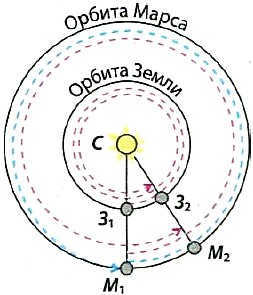
Fig. 4.2. The blue dotted line represents the path of Mars’ orbit around the Sun during its sideric period, while the red dotted line represents its synodic period.
The synodic period refers to the time it takes for bodies to move relative to both the Earth and the Sun. It is the interval during which we observe the same consecutive configurations of the planets, such as opposition, conjunction, and elongation. In Fig. 4.2, the positions of S-Z 1 -M 1 and S-3 2 -M 2 represent two consecutive oppositions of Mars. The synodic S and sideric T periods of a planetary orbit are related as follows:
Kepler’s Laws
Johannes Kepler (Figure 4.3) made the discovery that Mars revolves around the Sun in an elliptical path, and further studies confirmed that the orbits of other planets are also elliptical.

Figure 4.3. I. Kepler (1571-1630)
Kepler’s initial principle . The Sun is positioned at one of the foci of the ellipses on which all planets revolve around it (Fig. 4.4, 4.5).
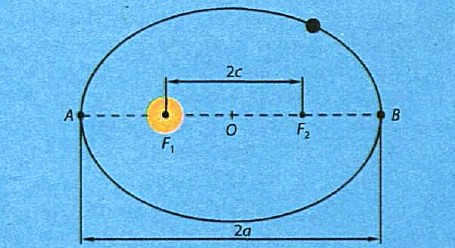
Figure 4.4: The planets revolve around the Sun in elliptical orbits. AF1 = Fmin – at the point of closest approach to the Sun, BF1 = Fmax – at the point of farthest distance from the Sun
Kepler’s first law has an important implication – the distance between a planet and the Sun is not constant and varies within the range: rmax ≤ r ≤ rmin
The point A on the orbit, where the planet comes closest to the Sun, is called perihelion (derived from Greek peri – near and helios – Sun), and the farthest point B from the Sun’s center on the planet’s orbit is called aphelion (derived from Greek aro – far away). The sum of the distances at perihelion and aphelion is equal to the major axis AB of the ellipse: rmax + rmin = 2a. The major semi-axis of the Earth’s orbit (OA or OB) is referred to as the astronomical unit. 1 a.e = 149.6×10^6 km.
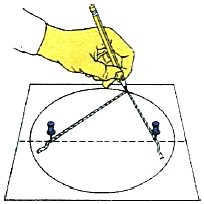
Figure 4.5. The proper technique for sketching an ellipse
The eccentricity e, which is the ratio of the distance between the focuses 2c to the length of the major axis 2a, characterizes the degree of elongation of the ellipse. In total, there are 5 stars that can be observed with the naked eye from Earth, which are Venus, Mars, Mercury, Jupiter, and Saturn. Some individuals claim to have even observed Uranus and Neptune, although it is unknown if they actually possess such extraordinary vision. Thus, their word must be taken for it.
Observing instructions
First, let’s consider the beautiful and enchanting Venus. It is the third brightest object in the solar system, with the Sun and the Moon being the first two. Venus can be seen by anyone who gazes up at the sky in the morning or evening. It is the only star visible during dawn when the others are not perceptible to our eyes. Depending on the weather, Venus can also be observed during the daytime in moderate weather. This is more common during late spring and early summer, when the sun shines brightly and Venus is positioned higher above the horizon than at other times of the year.
The enigmatic Mars is also quite visible in the sky, but it should be observed during “opposition” times. During these periods, its apparent size increases significantly. The ideal time to observe this star is when the largest approach occurs, which happens once every 17 years. Furthermore, favorable weather conditions are necessary when searching for Mars in the firmament, as it constantly moves across the night sky. Mars exhibits red and orange hues. Another highly visible planet is the colossal Jupiter. Although it is less visible than Venus, it is still well observable. Jupiter has a bright yellow color and can be perfectly seen during “opposition” times, when it comes as close to Earth as possible. At this point, the planet becomes visible almost immediately with the onset of night, and sometimes even at dusk. This is the prime time to observe Jupiter, as Venus is no longer visible during this time of day. In the late night, Jupiter can be found on the southern side, high in the sky. If one is familiar with the planet itself, it is difficult to mistake it for an ordinary star, as Jupiter stands out with its size and bright yellow hue.
Mercury, although close to our Earth, is not as visible as the aforementioned stars due to its small size. Nevertheless, it is still relatively easy to observe due to its brightness. However, it is not possible to do so as frequently as one would like, as Mercury is in close proximity to our Sun, which obscures the planet with its rays. Thus, it is necessary to seize the opportunity to observe Mercury when it is far from a bright star. In the fall, it can be observed during sunrise, and in the spring, 30 minutes after sunset.
Saturn should also be observed during times of maximum approach, as it may even be more visible than all the previous planets. This is due to its distinctive rings, which reflect the light emitted by our Sun. From Earth, Saturn appears as a glowing white dot.
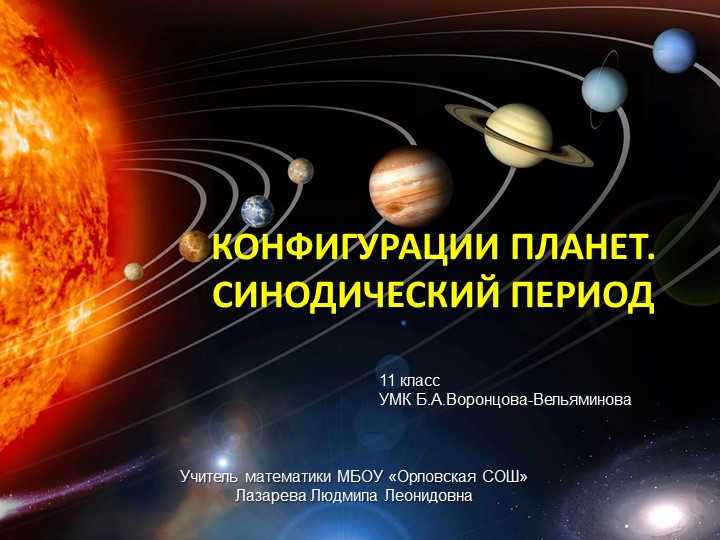
At present, 58,740 educational institutions have the opportunity to benefit from additional cumulative discounts ranging from 2% to 25%. To determine the specific discount applicable to all staff members of your educational institution, please access your personal Infoworks account.


Professional course for retraining
Methodological activities in early childhood education
In addition to this discount, you can also avail the discount provided by your educational institution (which is based on the number of your colleagues who have undergone Infoworks courses).
Presently, there are 58,740 eligible educational institutions that can receive additional discounts (ranging from 2% to 25%). To know the discount applicable to all employees of your educational institution, please log in to your personal Infoworks account.


Preparation for the Chemistry USE Exam in the Implementation of FSES LLC
Our professional development course is designed to help you prepare for the Chemistry USE exam in the context of the implementation of FSES LLC. We understand the peculiarities of this exam and provide targeted training to ensure your success.
Additionally, we offer discounts for educational institutions. If your colleagues have taken Infowork courses, we can add your institution’s discount to this offer. The discount amount depends on the number of colleagues who have already participated in our courses.
Currently, there are additional cumulative discounts available for 58,740 educational institutions, ranging from 2% to 25%. To find out the discount valid for all employees of your educational institution, simply log in to your personal Infoworks account.


Exploring innovative drawing methods for supporting children with disabilities in their corrective and developmental journey.
An in-depth look at the various slide presentations on non-traditional drawing techniques:

Slide 1: Different Arrangements of Planets. Understanding the Synodic Period
Teaching Mathematics at MBOU “Orlovskaya SOSH”
Presented by Ludmila Lazareva, 11th grade student
Based on B.A. Vorontsov-Vel’yaminoff’s curriculum

Slide 3 The Solar System is comprised of eight major planets, with Earth among them.
The planets closest to the Sun (Mercury, Venus) always stay within the Earth’s orbit. The planets further away (Mars, Jupiter, Saturn, Uranus, Neptune) orbit beyond it.
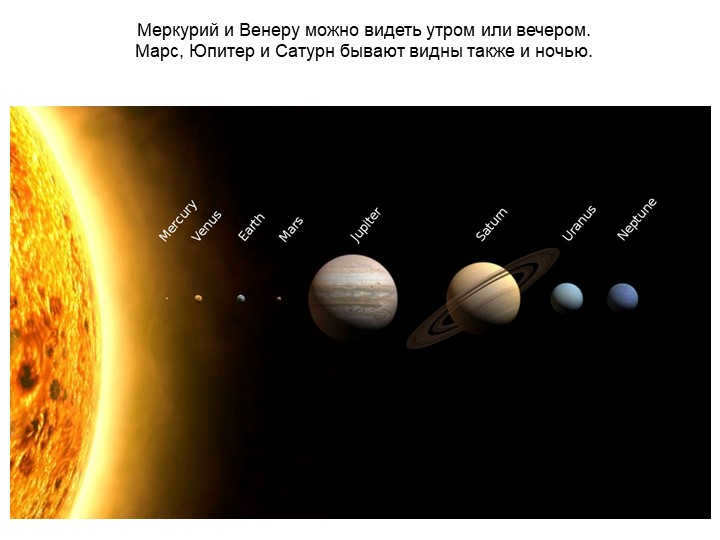
On the fourth slide, you can observe Mercury and Venus during the morning or evening hours.
In addition, Mars, Jupiter, and Saturn can also be seen at night.
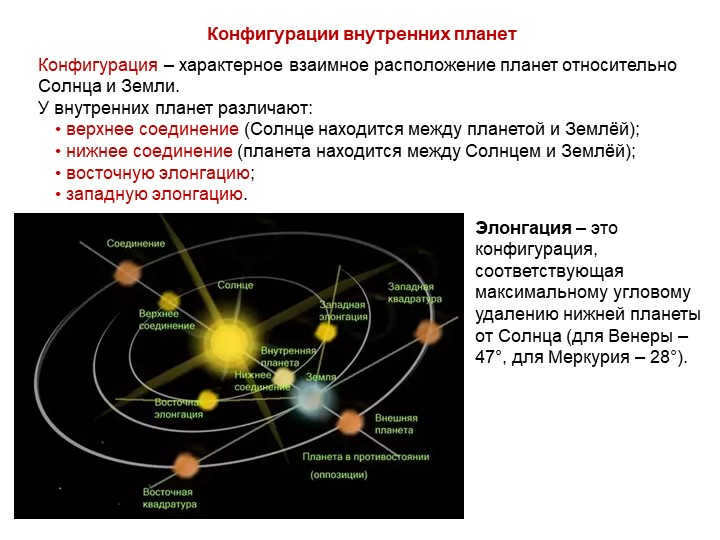
There are 5 different configurations of the inner planets in relation to the Sun and the Earth. These configurations are known as: upper conjunction, lower conjunction, eastern elongation, and western elongation.
Upper conjunction occurs when the Sun is positioned between the planet and the Earth. On the other hand, lower conjunction happens when the planet is positioned between the Sun and the Earth.
Eastern elongation refers to the configuration where the planet is at its maximum angular distance from the Sun, and western elongation is when the planet is at its minimum angular distance from the Sun.
Elongation is a characteristic feature of the inner planets, with Venus having a maximum angular distance of 47° from the Sun and Mercury having a maximum angular distance of 28°.
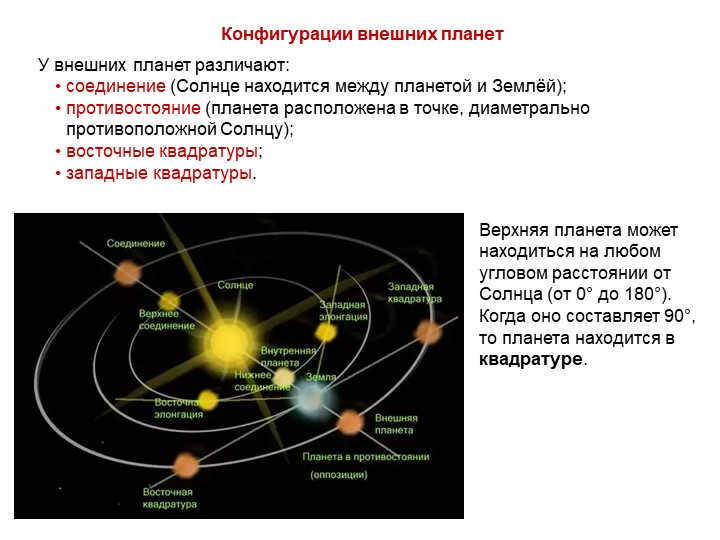
There are 6 different arrangements of the outer planets. These include:
- Conjunction: This occurs when the Sun is positioned between the planet and the Earth.
- Opposition: This happens when the planet is located on the opposite side of the Sun from the Earth.
- Eastern Quadratures: This occurs when the planet is positioned at an angle of 90 degrees from the Sun.
- Western Quadratures: This happens when the planet is positioned at an angle of 90 degrees from the Sun, but on the opposite side.
The upper planet can be at any angular distance from the Sun, ranging from 0 degrees to 180 degrees. When the planet is positioned at 90 degrees, it is considered to be in a quadrature.
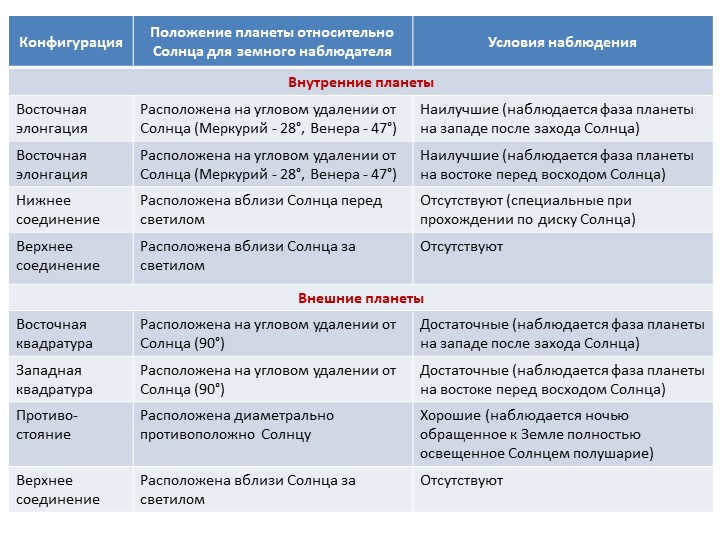

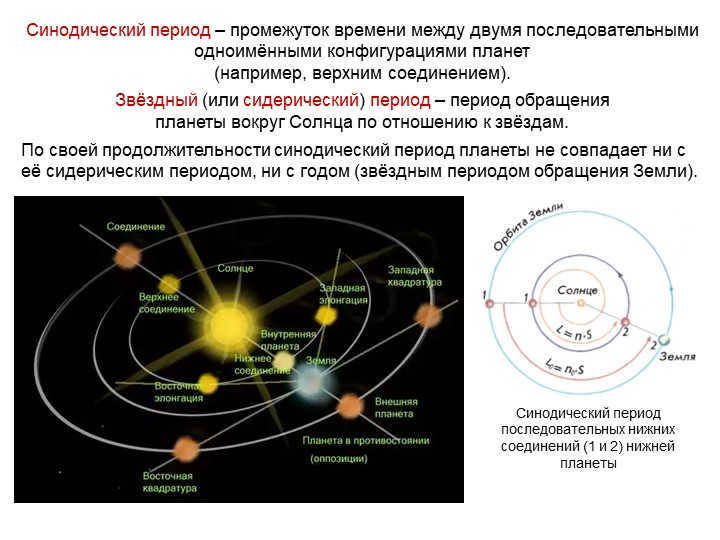
9 slide The synodic period represents the time interval between two consecutive configurations of planets with the same name (for example, an upper conjunction). The sidereal period, on the other hand, refers to the time it takes for a planet to complete one revolution around the Sun in relation to the stars. It is important to note that the synodic period of a planet does not align with either its sideric period or a year (which represents the stellar period of the Earth’s orbit). Lastly, the synodic period can also be used to measure the time between successive lower conjunctions (1 and 2) of the lower planet.
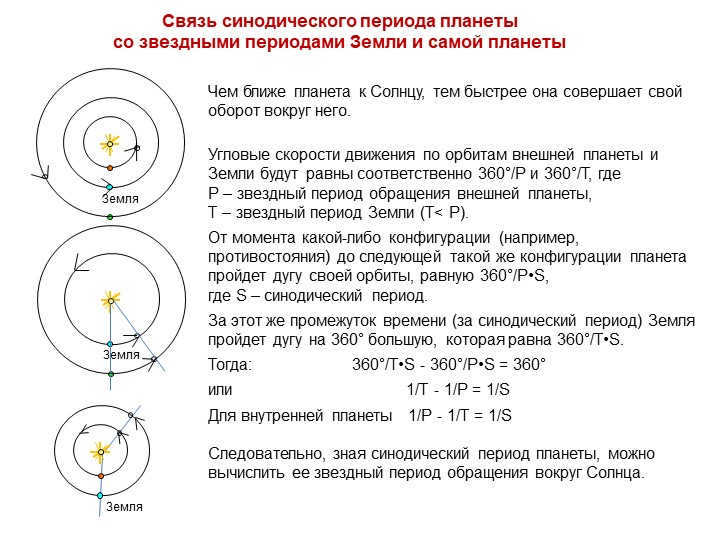
There is a connection between the synodic period of a planet and the periods of the Earth and the planet itself. The Earth, being closer to the Sun, has a faster revolution around it compared to other planets.
Therefore, by determining the synodic period of a planet, we are able to compute its sidereal period of orbit around the Sun.
Mother Earth
Our planet
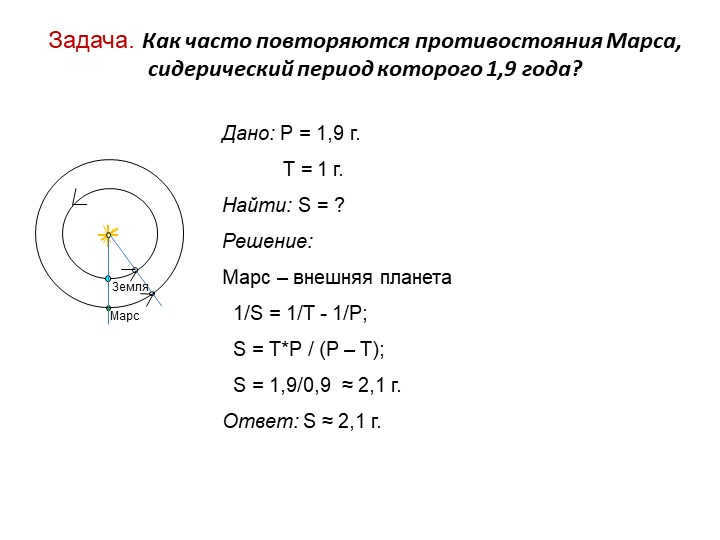
11 slide Problem. How frequently do the oppositions of Mars, which have a sideric period of 1.9 years, occur again?
Given: P = 1.9 yr.
T = 1 yr.
Find: S = ?
Solution:
Mars is considered an outer planet
1/S = 1/T – 1/P;
S = T*P / (P – T);
S = 1.9/0.9 ≈ 2.1 g.
Answer: S ≈ 2.1 g.
Earth
Mars
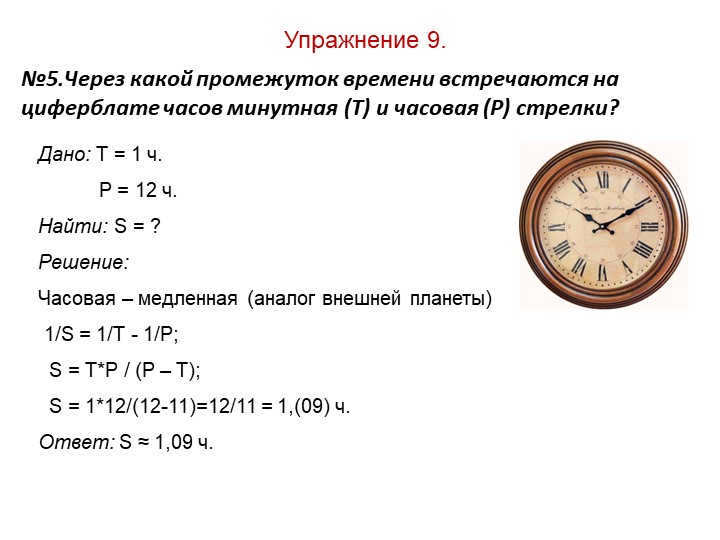
No.5. What is the time interval between when the minute hand and the hour hand meet on a clock face?
Given: The minute hand moves 1 hour.
The hour hand moves 12 hours.
Find: What is the time interval?
Solution:
The minute hand moves clockwise at a slower pace (similar to the outer planet).
1/S = 1/T – 1/P;
S = T*R / (P – T);
S = 1*12/(12-11)=12/11 = 1,(09) h.
The answer is S ≈ 1.09 hours.

Here are 13 slide questions for you to answer (p. 57):
1. How is the arrangement of a planet referred to?
2. How are the inner planets distinguished from the outer planets?
3. In what different configurations can a planet be found?
4. Which planets can be in opposition? And which ones cannot?
5. Can you identify the planets that can be sighted near the Moon during a full moon?
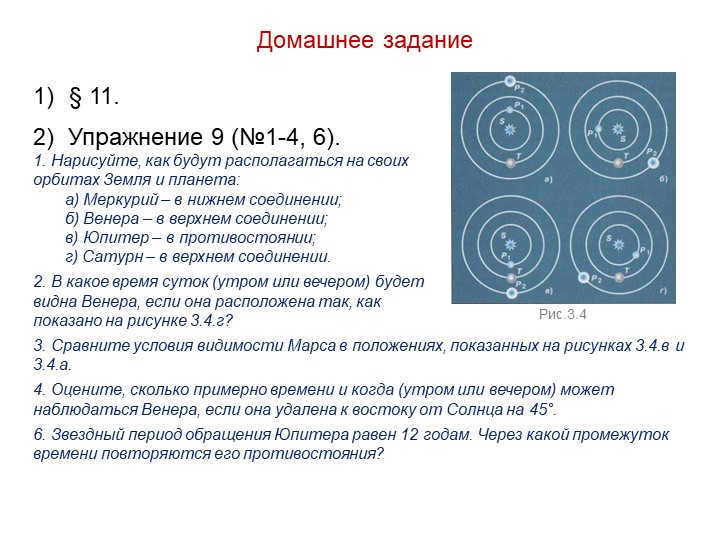
14 slide Homework
§ 11.
2) Exercise 9 (#1-4, 6).
1. Illustrate the positioning of the Earth and the planet on their respective orbits:
a) Mercury – in a lower conjunction;
b) Venus – in an upper conjunction;
c) Jupiter – in opposition;
d) Saturn – in an upper conjunction.
2. During which time of day (morning or evening) would Venus be visible if it is positioned as depicted in Figure 3.4.g.
as shown in Figure 3.4.d?
3. Compare the visibility conditions of Mars in the positions depicted in Figures 3.4.c and 3.4.a.
4. Approximate the duration and time of day (morning or evening) when Venus can be observed approximately when it is 45° east of the Sun.
6. Jupiter’s revolution has a stellar period of 12 years. How often do its oppositions occur within this time interval?
Figure 3.4

15 slide Vorontsov-Vel’yaminov B.A. Astronomy. Basic level. 11th grade: textbook / B.A. Vorontsov-Veliaminov, E.K.Straut. – Moscow: Drofa, 2017. – 238 pages
CD-ROM “Library of electronic visual aids “Astronomy, 9-10 grades”. LLC “Physikon”. 2003
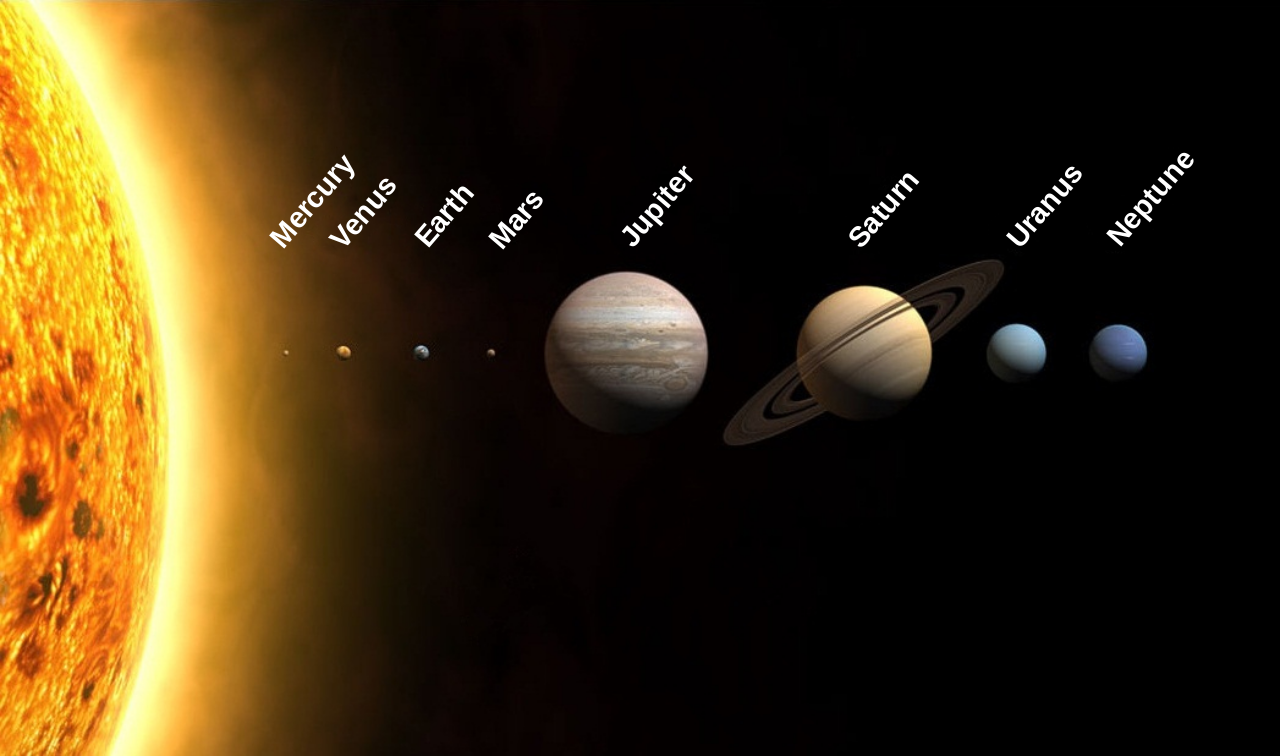




- Certificates for portfolio
- Eternal access for 99 rubles





